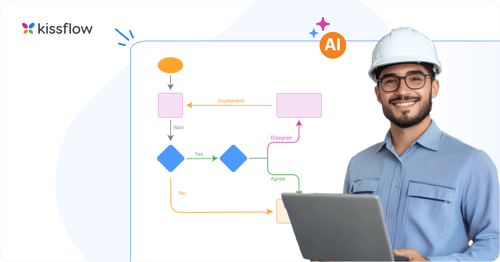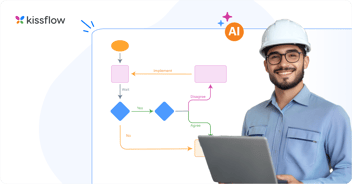
- >
- Workflow Platform>
- The ROI of AI Workflow Automation in Healthcare: From Patient Care to Administrative Efficiency
The ROI of AI Workflow Automation in Healthcare: From Patient Care to Administrative Efficiency
Healthcare organizations face a unique challenge. They need to deliver exceptional patient care while managing staggering administrative complexity, all under intense cost pressure. The traditional approach of simply adding more staff doesn't scale. Something has to change.
AI workflow automation is providing the answer. And the returns are remarkable. Hospitals report ROI of $3.20 for every $1 spent on AI, with typical returns realized within just 14 months.
But ROI in healthcare isn't just about dollars. It's about lives improved, errors prevented, and care teams empowered to focus on what they do best.
The administrative burden crisis
Let's start with the problem everyone knows but few quantify. Physicians spend an average of 5.8 hours per eight-hour patient schedule on electronic health record tasks, with clerical duties consuming the majority of this time.
Read that again. In an eight-hour shift, doctors spend nearly six hours on paperwork and system documentation. That's not patient care. That's box-checking in a digital form.
92 percent of healthcare leaders believe automation addresses staffing shortages, and they're right to focus here. When you're already short-staffed, every hour spent on administrative tasks is an hour not spent with patients.
Where AI workflow automation delivers patient-centric results
Clinical documentation: giving time back to clinicians
Traditional clinical documentation is a time thief. Doctors type during appointments, stay late writing notes, or dictate summaries that still require review and editing.
AI-powered ambient clinical documentation changes the game entirely. These systems listen to patient conversations, automatically generating structured clinical notes, coding suggestions, and follow-up recommendations.
The impact is immediate. AI-powered automation could free up 13 percent to 21 percent of nurses' time, translating to an additional 240 to 400 hours per nurse per year. For physicians, AI scanners have reduced paperwork time by 20 percent.
Kaiser Permanente's deployment of ambient documentation across 40 hospitals and 600+ medical offices marked the largest rollout in healthcare history and Kaiser's fastest implementation of a technology in over 20 years. They're not doing this for novelty. They're doing it because it fundamentally improves both provider experience and patient care.
Patient flow and care coordination
Hospital bottlenecks don't just frustrate patients. They create real clinical risk and operational inefficiency.
AI workflow automation optimizes patient flow from admission through discharge. In late 2024, a mid-sized American hospital integrated an AI triage solution with its EHR system. The AI analyzed patient symptoms, medical history, and real-time vitals using predictive algorithms. By correctly identifying high-risk patients, it allowed clinical staff to prioritize care and drastically cut down on wait times in emergency rooms.
43 percent of healthcare leaders are already using AI for in-hospital patient monitoring. These systems track patient status continuously, alerting care teams to deteriorating conditions before they become emergencies.
The downstream effects multiply. When you reduce delays at one point in the care continuum, you improve flow throughout the entire system. Patients get appropriate care faster. Beds become available for new admissions. Staff workload becomes more predictable.
Administrative workflows that actually work
Healthcare administration is drowning in complexity. Prior authorizations. Claims processing. Appointment scheduling. Billing inquiries. Each process involves multiple handoffs, manual reviews, and opportunities for error.
Administrative automation grew to 42 percent of all healthcare AI investment deals in 2024, up from 26 percent in 2019. The reason? Measurable, fast returns.
Two categories show particularly strong ROI: ambient clinical documentation ($600 million market) and coding and billing automation ($450 million market). Both address acute operational pain points and deliver measurable returns.
Prior authorization, healthcare's most reviled administrative process, is being transformed by AI. What once required hours of manual form completion and phone calls now happens automatically, with AI systems pulling relevant clinical data, checking coverage requirements, and even predicting approval likelihood.
The efficiency equation
Efficiency in healthcare isn't about cutting corners. It's about eliminating waste so resources flow to patient care.
40 percent of healthcare providers reported improved efficiency due to AI solutions. When we dig into what that means practically:
Reduced Documentation Time: Clinicians spend less time on paperwork, more time with patients.
Faster Decision Support: AI systems surface relevant patient information instantly, eliminating time spent searching through records.
Automated Routine Tasks: Appointment reminders, prescription refills, and basic patient inquiries happen automatically.
Optimized Resource Allocation: AI predicts patient volume and acuity, enabling better staffing and resource planning.
Hospitals report that ambient clinical documentation tools are the most universally adopted AI use case, with 100 percent reporting some usage as of 2025. This isn't experimental technology anymore. It's becoming standard practice because the efficiency gains are too significant to ignore.
The quality and safety connection
Here's where AI workflow automation becomes truly patient-centric. By reducing administrative burden and providing better decision support, these systems directly improve care quality.
In a study involving 14,606 patients, DeepRhythmAI achieved a false-negative rate of 0.3 percent, markedly lower than the 4.4 percent observed with technician analysis. When AI misses cases only 0.3 percent of the time versus 4.4 percent for human technicians, that's not just a statistical improvement. That's lives saved.
Operative reports generated by AI are now 87 percent accurate, higher than the 73 percent accuracy rate by surgeons themselves. When clinical documentation becomes more accurate and complete, downstream care improves across the board.
The "AI Consult" system deployed by OpenAI and Penda Health in Nairobi supported 20,000 clinicians and cut diagnostic and treatment errors by 16 percent and 13 percent, respectively. In healthcare, error reduction at that scale translates directly to better patient outcomes.
The ROI story: real numbers, real impact
Let's talk returns. The average ROI for AI in healthcare is $3.20 for every $1 invested, with typical returns seen within just 14 months.
But ROI manifests in multiple ways:
Direct Cost Savings: Reduced administrative labor costs, lower error rates, optimized resource utilization.
Revenue Improvement: Better coding accuracy, reduced claim denials, faster reimbursement cycles.
Capacity Creation: Time freed up for clinicians translates to more patient visits without adding staff.
Quality Improvements: Fewer errors, better outcomes, and higher patient satisfaction scores.
One comprehensive ROI calculator for an AI-powered radiology diagnostic imaging platform found that introducing AI into hospital radiology workflows resulted in labor time reductions and delivery of ROI of 451 percent over a five-year time horizon.
Portsmouth Hospitals automated maternity appointment scheduling with AI. Enterprise systems now automatically propose future appointments based on patient due dates and necessary scans. Appointments are booked within 24-48 hours instead of weeks. The systems send reminders to reduce missed appointments and alert midwives immediately if a patient or baby visits the emergency room.
The result? More patients seen, better continuity of care, happier staff, and measurable cost savings.
The implementation path
The AI healthcare market is projected to reach $36.96 billion in 2025, up from $14.92 billion in 2024, marking a 38.6 percent compound annual growth rate. But successful implementation isn't about buying the most comprehensive system. It's about starting with high-value workflows.
Successful healthcare organizations follow a pattern:
-
Identify High-Pain Workflows: Start where the burden is greatest and the benefit most obvious.
-
Ensure EHR Integration: Standalone tools create more work. Integration is essential.
-
Involve Clinical Champions: Technology adoption requires clinical buy-in and feedback.
-
Measure Rigorously: Track time savings, error rates, patient satisfaction, and financial metrics.
-
Scale Thoughtfully: Expand from proven successes to adjacent workflows.
Advocate Health evaluated over 225 AI solutions to select 40 use cases to go live with, including the largest deployment of Microsoft Dragon Copilot, imaging tools, and AI for call centers. These initiatives are projected to reduce documentation time by more than 50 percent while automating prior authorizations, referrals, and coding workflows.
The workforce reality
AI workflow automation isn't replacing healthcare workers. It's reshaping their roles in ways that improve job satisfaction and patient care.
80 percent of hospitals now use AI to improve patient care and operational efficiency. The care teams in these organizations spend less time on documentation and more time on direct patient interaction, clinical judgment, and the human elements of care that technology can't replicate.
As Dr. Shravan Verma, CEO of Speedoc in Singapore, puts it: "AI can triage, optimize logistics, and predict risks, but it cannot replace clinicians. Human empathy, judgment, and the ability to administer complex care are irreplaceable."
That's the point. AI workflow automation handles the routine and repetitive, freeing healthcare professionals to focus on what requires human expertise, empathy, and judgment.
Looking forward: the patient-centric imperative
72 percent of health system executives list improving consumer experience and engagement as a top priority for 2025. AI workflow automation is essential to delivering on this priority.
When clinicians have more time with patients because paperwork is automated, patient experience improves. When care coordination happens automatically in the background, transitions become seamless. When administrative friction disappears, healthcare feels more human, not less.
The ROI of AI workflow automation in healthcare isn't just financial, though the average $3.20 return for every $1 invested is compelling enough. The real return is measured in clinician time restored, patient experiences improved, and care quality elevated.
Healthcare organizations implementing AI workflow automation aren't choosing between efficiency and patient-centricity. They're discovering that reducing administrative burden and improving operational efficiency are prerequisites for truly patient-centered care.
The healthcare systems thriving in 2025 are those that have systematically automated their core workflows, not to reduce humanity in healthcare, but to create more space for it. When the technology handles the routine, humans can focus on healing. That's the promise of AI workflow automation in healthcare, and increasingly, it's the reality.
Streamlining healthcare operations without the complexity
Kissflow's healthcare workflow automation platform helps hospitals and clinics streamline everything from patient intake and care coordination to administrative approvals and billing processes. Built with healthcare compliance in mind and designed for easy integration with existing EHR systems, Kissflow enables healthcare organizations to automate complex workflows without disrupting patient care. Our intuitive interface means clinical and administrative staff can design and modify workflows without IT dependencies. Healthcare organizations using Kissflow report faster patient processing times, reduced administrative burden on clinical staff, and measurable improvements in both operational efficiency and patient satisfaction.
Business Process Reengineering (BPR) – Definition, Steps, and Examples [Guide of 2023]
Related Topics:
Related Articles










